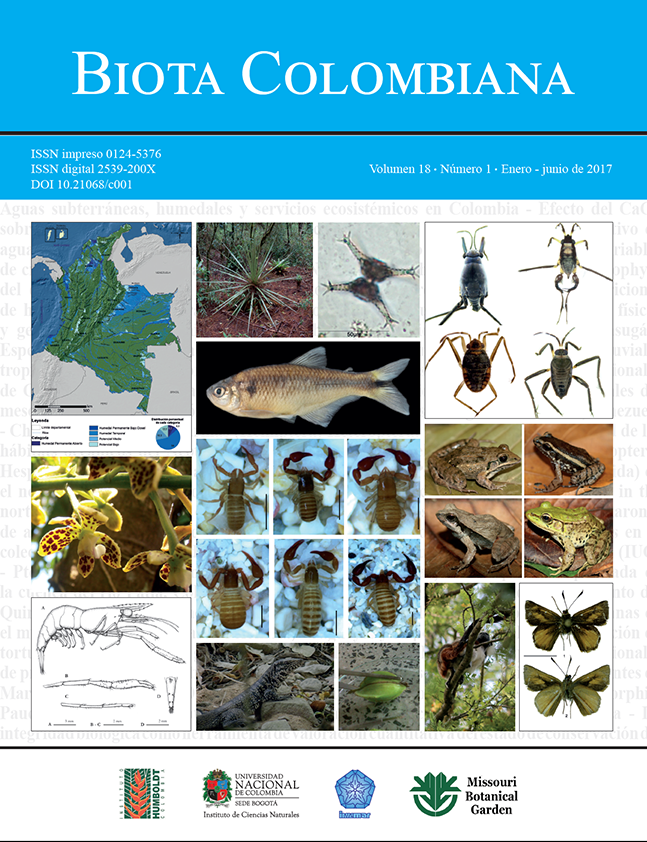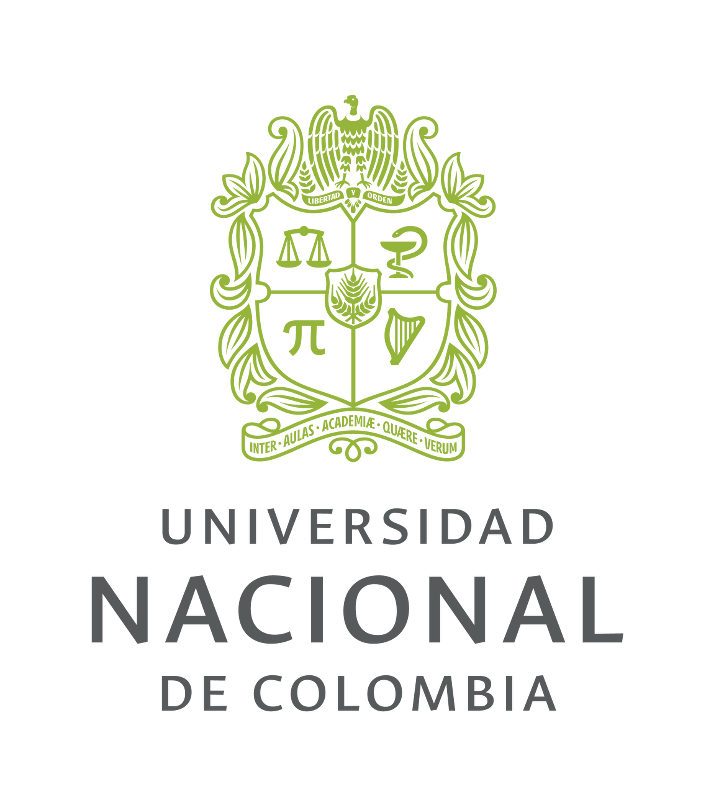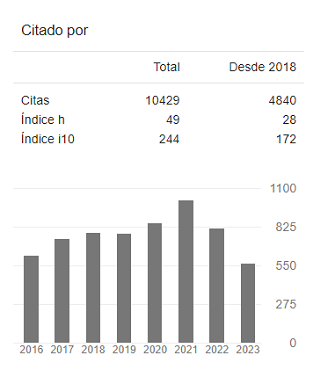Resumen (es):
Con el fin de determinar el efecto del calcio sobre la fisiología de Aloe vera sometida a dos niveles salinos
(100 y 150 mmol.m-3 de NaCl), se determinó el contenido relativo de agua del clorénquima (CRA), acidez
titulable, pigmentos, proteínas y prolina (Pro) clorenquimática a 25 plantas jóvenes de dicha especie. Ninguno
de los tratamientos salinos con o sin adición de calcio (NaCl+CaCl2) presentó diferencias estadísticamente
significativas sobre variables como el CRA y pigmentos (clorofilas a y b, clorofila total y carotenoides). El
tratamiento con NaCl provocó la disminución en los valores de acidez titulable, contenido de proteínas y
prolina. No obstante, al ser suplementadas con calcio y tratadas con las mismas concentraciones salinas, se
alivian los síntomas causados por tal estrés. Estos resultados indican que a una osmolaridad de 100 mmol.m-3
de NaCl, presente en medio radical, al ser suplementado con 10 mmol.m-3 de CaCl2 resulta propicio para el
cultivo de sábila en una zona donde se hallen problemas de sales disueltas en el suelo.
Resumen (en):
Palabras clave:
Calcium, CAM plants, CO2 fixation, Proline, Proteins (en)
Referencias
Ashraf, M. 1989. The effect of NaCl on water relations, chlorophyll, and proline contents of two cultivars of blackgram (Vigna Mungo L.). Plant and Soil 119: 205-210.
Ball, E., J. Hann, M. Klug, H. Lee, U. Lüttge, B. Orthen, M. Popp, A. Schimitt e I. Ting. 1991. Ecophysiological comportment of tropical CAM tree Clusia in the field. New Physiology 117: 473-481.
Colmer, T., T. Fan, R. Higashi y A. Läuchli. 1996. Interactive effects of Ca2+ and NaCl salinity on the ionic relations and proline accumulation in the primary root tip of Sorghum bicolour. Physiologia Plantarum 97: 421-424.
Dodd, A., A. Borland, R. Hanslam, H. Griffiths y K. Maxwell. 2002. Crassulacean acid metabolism: plastic, fantastic. Journal of Experimental Botany 53 (369): 569-580.
Epstein, E. 1961. The essential role of calcium in selective cation transport by plant cells. Plant Physiology 36: 47-444.
Franco-Salazar, V. y J. Véliz. 2007. Respuestas de la tuna [Opuntia ficus-indica (L.) Mill.] al NaCl. Interciencia 32
(2): 125-130.
Franco-Salazar, V. y J. Véliz. 2008. Efectos de la salinidad sobre el crecimiento, acidez titulable y concentración de clorofila en Opuntia ficus-indica (L.) Mill. Saber 20 (1): 12-17.
Franco-Salazar, V., J. Véliz y L. Astudillo. 2012. Ecofisiología de Aloe vera (L.) Burm. f. en Guayacán, Península de Araya, estado Sucre, Venezuela. Interciencia 37 (6): 444-450.
Fuentes-Carvajal, A., J. Véliz y J. Imery. 2006. Efectos de la deficiencia de macronutrientes en el desarrollo vegetativo de Aloe vera. Interciencia 31 (2): 116-124.
García, O. 2008. Crecimiento y desarrollo de Aloe vera bajo diferentes condiciones de salinidad. Trabajo de grado. Universidad de Oriente, escuela de Ciencias, Departamento de Biología. Cumaná, 38 pp.
García, M. y E. Medina. 2009. Acumulación de iones y solutos orgánicos en dos genotipos de caña de azúcares estresados con sales simples o suplementadas con calcio. Bioagro 21: 3-14.
García, A., J. Engler, S. Lyer, T. Gerats, M. Van Montagu y A. Caplan. 1997. Effects of osmoprotectans upon NaCl stress in rice. Plant Physiology 115: 159-169.
Ghoulam, C., A. Foursy y K. Fares. 2002. Effects of salt stress on growth, inorganic ions and proline accumulation in relation to osmotic adjustment in five sugar beet cultivars. Environmental and Experimental Botany 47: 39-50.
Goldstein, G., J. Ortega, A. Nerd y P. Nobel. 1991. Diel patterns of water potencial components for the Crassulacean acid metabolism plant Opuntia ficus-indica when well-watared or droughted. Plant Physiology 95: 274-288.
Hasegawa, P. y R. Bressan. 2000. Plant cellular and molecular responses to high salinity. Annual Review of Plant Physiology 51: 463-499.
Hanscom, Z. y I. Ting. 1978. Responses of succulents to plant water stress. Plant Physiology 61: 327-330.
Iwasaki, I., H. Arata, H. Kijima y M. Nishimura. 1992. Two types of channels involved in the malate ion transport across the tonoplast of a crassulacean acid metabolism plant. Plant Physiology 98: 1492-1497.
Kluge, M. y M. Schomburg. 1996. The tonoplast as a target of temperature effects in Crassulacean acid metabolism. Pp: 72-77. En: Winter, K. y J. A. C. Smith. (Eds.). Crassulacean acid metabolism. Bioshemistry, ecophysiology and evolution. Ecological Studies, vol 114. Berlin, Heidelberg, New York: Spriger-Velarg.
Lauchli, A. y S. Grattan. 2007. Plant growth and development under salinity stress. Pp: 1-32. En: Matthew A., J., P. M. Hasegawa y J. S. Mohan (Eds.). Advances in Molecular Breedling Toward Drought and Salt Tolerant Crops. Springer. California. U.S.A.
Levent, A., K. Cengiz, A. Muhammad, A. Hakan, Y. Ibrahim y Y. Bulent. 2007. The effects of calcium sulphate on growth, membrane stability and nutrient uptake of tomato plants grown under salt stress. Environmental and Experimental Botany 59: 173-178.
Li, Q., J. Cao, L. Yu, M. Li, J. Liao y L. Gan. 2012. Effects on physiological characteristics of Honeysuckle (Lonicera japonica Thunb) and the role exogenous calcium under drought stress. Plant Omics Journal 5 (1): 1-5.
Lowry, O., N. Rosebrough, A. Farr y R. Randall. 1951. Protein measurement with the Folinphenol reagent. Journal Biological Chemistry 193: 265-275.
Lüttge, U. 2004. Ecophysiology of Crassulacean Acid Metabolism (CAM). Annals of Botany 93: 629-652.
Lüttge, U., M. Kluge y G. Bauer. 1993. Botánica. McGraw-Hill Interamericana. España. pp 523
Meloni, D. 2012. Respuestas fisiológicas a la suplementación con calcio de plántulas de vinal (Prosopisrus cifolia G.) estresadas con NaCl. Revista de la Facultad de Ciencias Agrarias UNcuyo 44 (2): 79-88.
Nedjimi, B. y Y. Daoud. 2009. Effects of calcium chloride on growth, membrane permeability and root hydraulic conductivity in two Atriplex species grown at higt (sodium chloride) salinity. Journal of Plant Nutrition 32: 1818-1830.
Nobel, P. 2006. Parenchyma-chlorenchyma water movement during drought for the hemiepiphytic cactus Hylocereus undatus. Annals of Botany 97: 469-474.
Pimienta, E., M. González y P. Nobel. 2002. Ecophysiology of a wild platyopuntia exposed to prolonged drougth. Enviromental and experimental Botany 47: 77-86.
Poljakoff-Mayber, A., G. Somers, E. Waker y J. Gallagher. 1994. Seeds of Kosteletz kyavirginica (Malvaceae): their structure, germination, and salt tolerance. II. Germination and salt tolerance. American Journal of Botany 81: 54-59.
Prat, D. y R. Fathi. 1990. Variation in organic and minerals components in young Eucaliptus seedlings under saline stress. Physiology Plantarum 79: 479-486.
Rains, D. y E. Epstein. 1967. Sodium absorption by barley roots: role of the dual mechanisms of alkali cation transport. Plan Physiology 42: 314-318.
Rayder, L. y I. Ting. 1981. Carbon metabolism in two species of Pereskia (Cactaceae). Plant Physiology 68: 139-142.
Ross, C. 1974. Plant Physiology laboratory manual. Wadsworth Publishing Company, Inc. Belmont, California. U.S.A. 200 pp.
Serrano, R., J. Mulet, G. Ríos, J. Márquez, I. de Larrinoa, M. Leube, I. Mendizabal, P. Ahuir, M. Proft, R. Ros y C. Montesinos. 1999. A glimpse of the mechanisms of ion homeostasis during salt stress. Journal of Experimental Botany 50: 1023-1036.
Schomburg, M. 1994. Untersu chugenuber das thermotrope Phasenver halten das tonoplastenbei der CAM Pflanze Kalanchoe daigremontiana. Dr. rer. nat. Thesis. Darmstadt: fachbereich Biologie, Thechnical University.
pp.
Shah, S., S. Wainwright y M. Merrett. 1990. The interaction of sodium and calcium chlorides and light on growth, potassium nutrition, and proline titulation in callus cultures of Medicago sativa L. New Phytologist 116: 37-45.
Sokal, R. y F. Rohlf. 1979. Principios y métodos estadísticos en la investigación biológica. H. Blume Ediciones. Madrid. España. Pp: 832.
Takemoto, B., A. Bytnerowicz y D. Olszyk. 1988. Depression of photosynthesis, growth, and yield in field-grown green pepper (Capsicum annum L.) exposed to acidic fog and ambient ozone. Plant Physiology 88: 477-482.
White, P. y M. Broadley. 2003. Calcium in plant. Annals of Botany 92: 487-511.
Cómo citar
Las obras publicadas en las revistas del Instituto de Investigación de Recursos Biológicos Alexander von Humboldt están sujetas a los siguientes términos, con relación al derecho de autor:
1. Los derechos patrimoniales de las obras publicadas tienen como titular al Instituto de Investigación de Recursos Biológicos Alexander von Humboldt. Los autores o las instituciones que elaboran el documento aceptan ceder los derechos patrimoniales al Instituto Humboldt con el envío de sus artículos, lo que permite –entre otras cosas– la reproducción, comunicación pública, difusión y divulgación de las obras.
2. Las obras de ediciones digitales se publican bajo una licencia de Creative Commons Colombia:
Esta obra está bajo una Licencia Creative Commons Atribución-NoComercial-SinDerivar 4.0 Internacional.
Atribución – No comercial – Sin Derivar: Esta licencia es la más restrictiva de las seis licencias principales, sólo permite que otros puedan descargar las obras y compartirlas con otras personas, siempre que se reconozca su autoría, pero no se pueden cambiar de ninguna manera ni se pueden utilizar comercialmente.
3. Los autores, al someter artículos al proceso editorial de las revistas editadas por el Instituto Humboldt, aceptan las disposiciones institucionales sobre derechos de autor y acceso abierto.
4. Todos los artículos recibidos serán sometidos a un software antiplagio. El sometimiento de un artículo a las revistas del Instituto Humboldt se entiende como la aceptación de la revisión para detectar posible plagio.
5. Las obras sometidas al proceso de edición de las revistas del Instituto Humboldt deben ser inéditas.


















